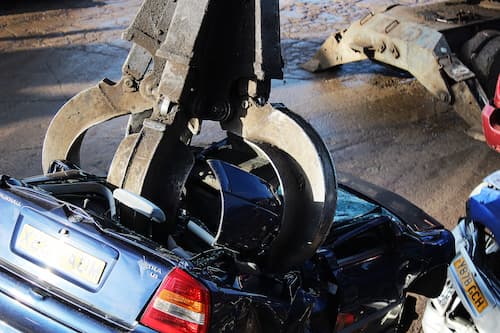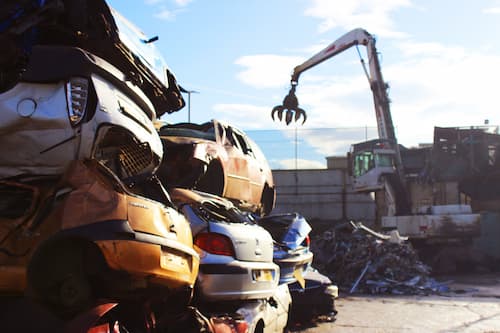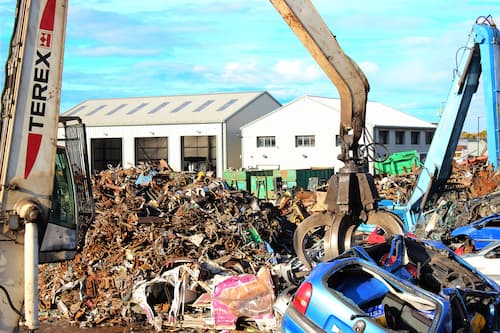An average of one million cars are crushed and scrapped every year. When a car isn’t of value anymore or isn’t being used, many people will opt for scrapping it. At the end of the cars useful life, vehicles do have value as a source of spare parts, which has created an industry for vehicle dismantling. Scrap metal recycling is also a great way to help the environment, as it lessens need to produce new metals and therefore saves energy.
You may understand the basics; the vehicle is shredded, and the metal content is retrieved for recycling, but have you ever wondered what happens between the car arriving at the facility and it becoming a cube of metal at the end?
Here are the various stages of what happens to your vehicle once its miles are long gone. Trust us when we say it’s in safe hands.
Arriving and Transferring
When your car arrives, it will be lifted to the correct area to go through the vehicle depollution process. This is the process of separating and removing many components that have the potential to cause harm to the environment.
You must take your car to an authorised treatment facility for health and safety reasons. Before your vehicle can be recycled, it is vital that this process is carried out to protect the environment.
Vehicle Depollution Process
Once the vehicle is transferred to a covered depollution building, the oils, fuel, battery acid, coolants, anti-freeze, windscreen wash and refrigerants are all removed, as these can contaminate the earth.
These fluids, if disposed of incorrectly by an uncertified facility, can enter the water supply and the food chain, which can cause a huge amount of problems to nature, wildlife and of course, health.
The battery will be removed for recycling as well as other hazardous materials such as any switches which may contain mercury. The tyres are removed, and airbags will be deployed for safety reasons when crushing the vehicle. Here is a list of components that the qualified ATF (Authorised Treatment Facility) employee will remove to properly depollute your vehicle at the end of its life:
- Battery – Lead Acid is hazardous and will be disposed of
- Tyres – Controlled Waste (The records of the disposal are kept for two years and the regulations for storage must be followed accordingly)
- Wheels and Lead Balance Weights – Lead is a hazardous material and all items made from this should be disposed of correctly. The wheels can be recycled or reused if possible.
- Liquid Petroleum Gas Tank – This is hazardous, however not all vehicles have LGP tanks
- Airbags – Airbags are potentially explosive even after being set off, due to the chemicals they may contain and the reaction they can cause during impact
- Seat Belts and Pre-Tensioners – Pre-tensioners are potentially explosive and are classed as a hazardous material due to the nature of the chemicals they contain
- Oils, Fluids and Liquids – All oils, lubricants, fuel, coolants, refrigerants, anti-freeze fluids and wash fluids are hazardous to the environment
- Catalytic Converter – This can be controlled waste if the converter is intact; however, it can also be classed as hazardous if open and the material is exposed
- Oil Filter – This is hazardous, as oils from the filters can leak
- Switches Containing Mercury – Mercury is a toxic material and can contaminate soil and water
The vehicle will be connected to a depollution rig to drain the necessary liquids. The fluids will be pumped into sealed tanks, so they are ready for specialist recycling or disposal.
Next Steps
The metal, once glass, plastic and rubber are removed from the mix is sold by the tonne to steel mills for recycling.
Once the specialist parts have been removed, including any remaining glass and bulky items such as the back and front bumper, the remaining pieces of the vehicle can go on for further processing. This can include removal of the air conditioner evaporator, heater core and wiring harnesses. If this is not required, the remaining shell is either crushed flat or into a cube, which facilitates a more economical transportation to a shredder or mill, where the cubes are then reduced further into fist-sized chunks of metal.
Recycling within the steel industry saves enough energy to power around 18 million households for an entire year. Recycling your metal also uses around 74% less energy than it does to produce it. Through choosing to recycle your car in this manner you are helping to save energy and natural resources.
Morecambe Metals are an ATF and provide vehicle recycling services for end of life vehicles. All vehicles depolluted with our team will be deregistered and a Certificate of Destruction (CoD) will be issued by the DVLA.
We are committed to ensuring we follow all guidelines, making sure we conduct a proper and legal recycling service for your vehicle. Our unique method of vehicle depollution also makes sure that our services are much more environmentally friendly in comparison to many of our competitors.
If you would like any further information and are thinking of scrapping your car, Morecambe Metals is your first port of call! Simply get in touch with our team or request a quote.




